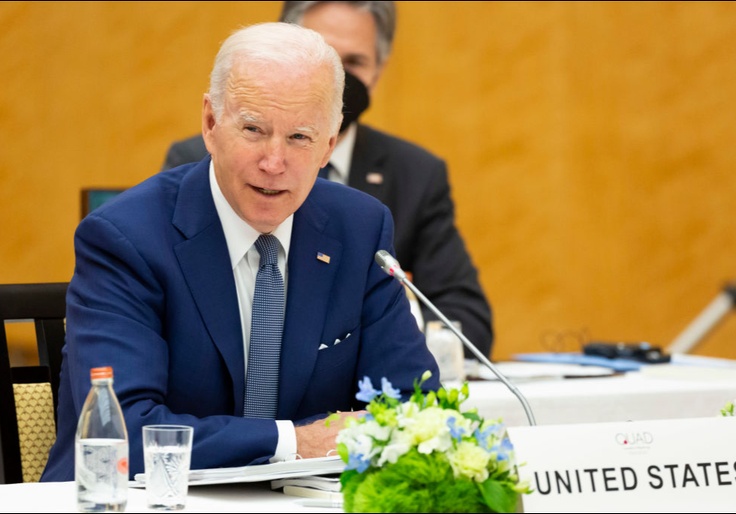
War was in the background of President Biden’s trip to Asia last week. He redeployed U.S. forces to Somalia before he left. He signed into law $40 billion in financial and military assistance to Ukraine during his visit to South Korea. Then, in Japan, a reporter asked Biden if he was prepared to “get involved militarily to defend Taiwan.” Biden’s answer was succinct. “Yes,” he said.
Forget the clumsy White House reaction to Biden’s moment of lucidity. Leave aside the question of whether the United States should move from a policy of strategic ambiguity, where our response to a Chinese invasion of Taiwan is left undefined, to a policy of strategic clarity where we let China know the direct consequences of such an attack.
Consider instead the following: Does the Pentagon have the resources to defend democracies from autocrats in two hemispheres?
Afraid not. The Pentagon ditched the “two-front” war preparedness strategy under Barack Obama. Meanwhile U.S. defense spending as a percentage of the economy has been in decline for decades. Biden has shown little interest in changing its downward course. Indeed, the one place where he’s been reluctant to spend money is national defense.
Biden’s fiscal year 2022 request of $715 billion was too small even for the Democratic Congress. It ended up authorizing $728.5 billion. Biden’s fiscal year 2023 request is for $773 billion. Maybe that seems like a hefty sum. It’s not. Biden’s defense budget is meager compared with the tasks the president has set out.
Why? Part of the reason is inflation. The Biden budget request paints a rosy—and inaccurate—scenario. My American Enterprise Institute colleague Mackenzie Eaglen has run the numbers. She begins with the $773 billion marked for the Pentagon. “Using a more honest 7.46 percent CPI [Consumer Price Index] estimate (the FY22 average so far) for military personnel raises the topline to $794.5 billion needed next year,” she writes.
That still isn’t enough, however. “$846 billion in FY 2023 is a more realistic down payment on matching defense investments against national security threats,” Eaglen concludes, “and should be the starting point as Congress builds a more accurate defense budget.” In other words, Eaglen recommends a 9 percent increase in the Biden administration’s topline before Congress and its appropriators become involved. Her proposal makes sense. It’s necessary. And it won’t happen.
It won’t happen for several reasons. The first is inertia. None of the threats we encountered or fear we might encounter in the post-Cold War world have provoked the people’s representatives to increase defense spending to Reagan-era levels. The political willpower doesn’t exist. Entitlements and interest on the debt act as additional constraints. We’ve muddled through for 30 years, this thinking goes. No need to stop now.
The second brake on defense spending is the Progressive bias against hard power. By the 2024 election, America will have been governed by presidents skeptical of defense spending and the military for 12 of the past 16 years. Such leadership has an effect not only on materiel but also on the culture of the national security establishment. Progressives under Obama and Biden see the Pentagon more as a vehicle for social policy and geopolitical featherbedding than as an instrument of deterrence and the national interest. Left-wing taboos against nuclear weapons, nuclear power, oil and gas, and the warrior mindset take precedent over military readiness and lethality. The president overrules the secretary of defense and joint chiefs. America grows weaker even as its leader calls for greater global activism.
Noninterventionism and restraint on the foreign policy right creates a bipartisan reluctance to spend more on defense. President Trump increased defense spending, but not by enough. His administration was filled with skeptics of American engagement and foreign intervention who wanted to reduce not only the Pentagon’s budget but also its influence throughout the world. Republican voices in Congress promote an “America First” foreign policy that would constrict U.S. deployments, aid, and partnerships.
About a quarter of the House GOP and a fifth of the Senate GOP, for example, voted against the latest aid package to Ukraine. Granted, this batch of aid seemed designed to split conservatives, who have a longstanding aversion to unconditional economic assistance. The vote stands as a warning for both liberal and conservative internationalists, nonetheless. The bipartisan consensus over Ukraine may not survive a prolonged war of attrition.
You correct a mismatch between resources and commitments by increasing resources or decreasing commitments. President Biden resists increasing resources for national defense, while powerful elements of both left and right work to reduce American commitments. Neither strategy makes America safer. Someone needs to make the case for a major U.S. defense buildup in response to the challenges of China, Russia, and Iran. And they need to do it soon.
